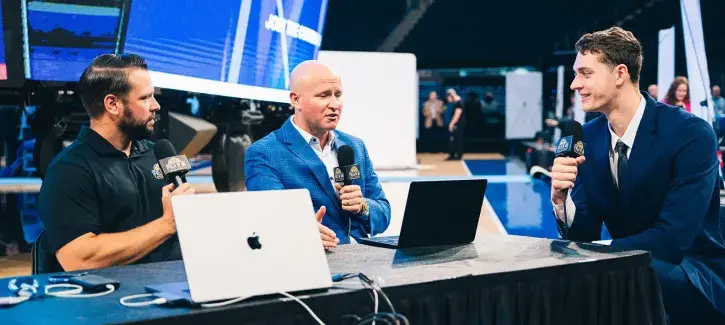
Understanding NIL: What student-athletes and their families need to know

In recent years, three letters have transformed the landscape of college sports: NIL.
What is NIL and why it matters
Short for Name, Image and Likeness, NIL refers to the right of student-athletes to profit from their personal brand, including endorsements, sponsorships, social media content, appearances and more. Think Caitlin Clark’s estimated $3.1 million worth as a college athlete. She is not only the most highly recognized female basketball player but, through brand partnerships, is the face of—unsurprisingly—Nike and Gatorade, as well as less obvious endorsement deals with State Farm and Hy-Vee.
Though the concept has existed for decades, NIL has gained national attention over the past 10–15 years, largely because of lawsuits filed by student-athletes challenging the NCAA’s long-standing rules that prohibited them from earning money while playing college sports. Legal victories, most notably the U.S. Supreme Court’s 2021 ruling in NCAA v. Alston, have shifted public sentiment—and policy—in favor of student-athletes.
Today, student-athletes can monetize their fame without jeopardizing their eligibility. From TikTok and Instagram influencers to local sponsorship deals, high school and college athletes now have more opportunities than ever to benefit financially from their talents and hard work.
“It used to be a widely held belief that athletes should play for the name on the front of the jersey, not the back,” says David Weber, JD, formerly a professor at Creighton University School of Law and currently an associate professor at the University of Oregon School of Law, “but public perception has changed in favor of compensation for student-athletes, especially when a college injury can shutter a pro career.”
Where many once believed student-athletes were already “compensated” with scholarships, there’s now broader recognition that these athletes generate significant value for their school—especially at top programs, says Weber. Support for NIL reflects a growing belief that athletes deserve a share of that value.
Navigating NIL contracts and legal issues
But with new opportunity comes new responsibility. It’s critical for student-athletes and their families to understand their rights. Navigating NIL deals, contracts and representation can be complex, with missteps potentially affecting both eligibility and future earnings. Coaches, parents and school administrators play a vital role in helping athletes make informed decisions.
In the last 10 years with its move to the BIG EAST Conference, Creighton has become a rising brand in college athletics, Weber says. The University has kept pace with NIL’s role in the sporting arena with sports law concentrations at the School of Law and summer courses for student-athletes at the Heider College of Business, for instance. Now, it is emerging as a leader in the field with the College of Professional and Continuing Education’s new NIL Certificate Program.
Creighton’s NIL Certificate Program: preparing athletes
The new NIL Certificate Program for student-athletes is tailor-made for both high school and college athletes and their parents, high school athletic directors and coaches, individuals considering hiring an agent and promising NIL players. Courses will cover the legal risks of NIL for athletes. Instructors will walk students through sample contracts to familiarize them with what should—and shouldn’t—be in the typical NIL contract, including what contract clauses should give players pause. International student-athletes will learn about student visas and balancing NCAA compliance and NIL opportunities. All participants will walk away with concrete, actionable knowledge.
Weber says the NIL Certificate Program will also equip adults with knowledge vital to advising the student-athletes under their direction. “Coaches and athletic directors are often the first point of contact for student-athletes,” he says. “The better informed they are on NIL, the better the guidance they can provide.”
NIL opportunities for student-athletes
To date, much of the attention has focused on major Division I programs and big-name athletes. But NIL is impacting all levels of college athletics. Athletes at smaller schools or in lower-profile sports are also finding ways to benefit, predominantly as social media influencers. “For lower profile sports, NIL will be more about personal brand and social media following,” Weber says, citing LSU gymnast Livvy Dunne, the highest-paid NIL female athlete with an estimated $4.1 million valuation, as a prime example.
NIL will only grow in importance, and its rapid progression excites Weber. The recent NCAA anti-trust settlement, known as the “House settlement,” is such an example. Effective as of July 1, it allows college athletics programs to compensate—directly and not just through scholarships—student-athletes for their NIL. Furthermore, House provides almost $3 billion in damages for former athletes. “While the House case has now been settled, nearly as many questions remain as before. The issues of college athlete employee status, the applicability of Title IX and the legality of the new NIL enforcement mechanisms continue to loom large,” warns Weber. “While some states have attempted to legislate in this area, this activity is piecemeal at best. Without a federal solution and answers to the outstanding issues above, college sports will continue to face challenges and uncertainty in this new era.”
Weber foresees a changing role for the NCAA as it adapts to the professionalization of college athletes and anticipates additional changes to the NIL landscape via litigation. When it does, Creighton will continue to expand its coursework in this growing field.
As NIL continues to evolve, one thing is clear: it’s changing the game. And for today’s student-athletes, being informed is just as important as being in shape.




